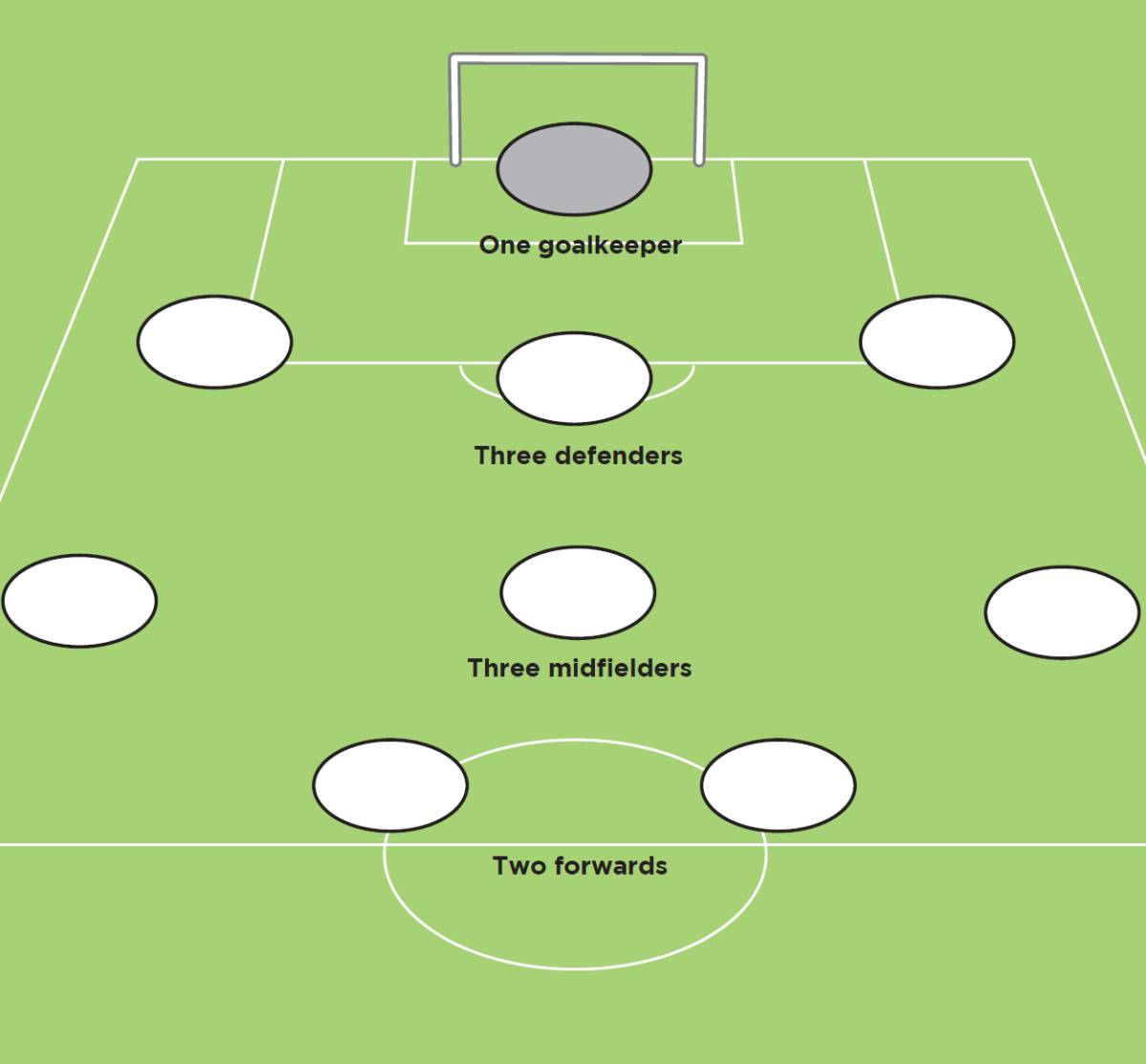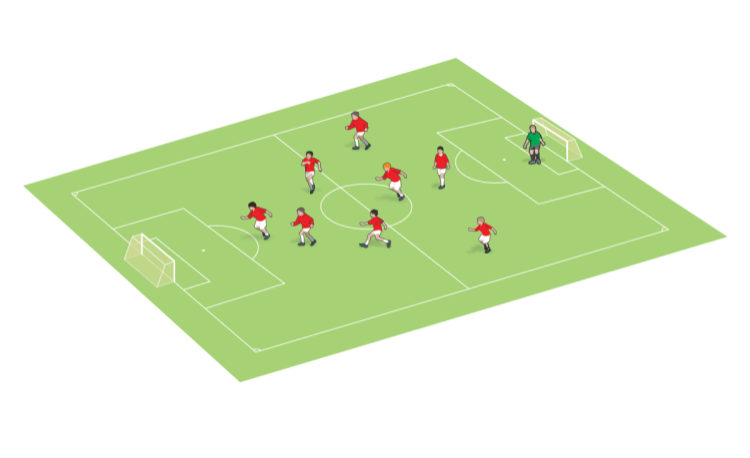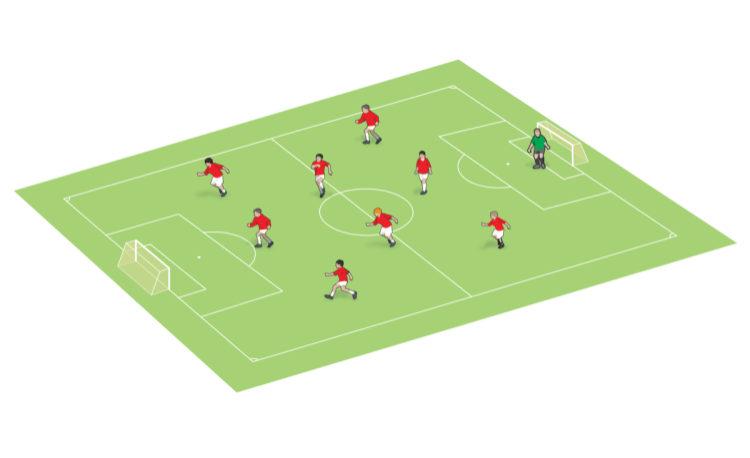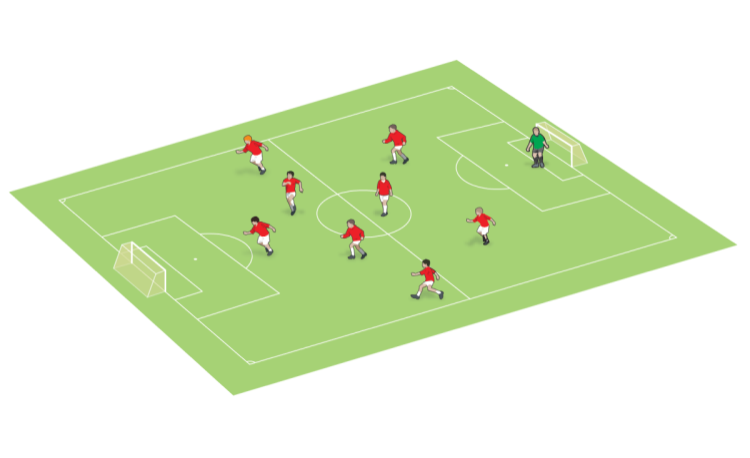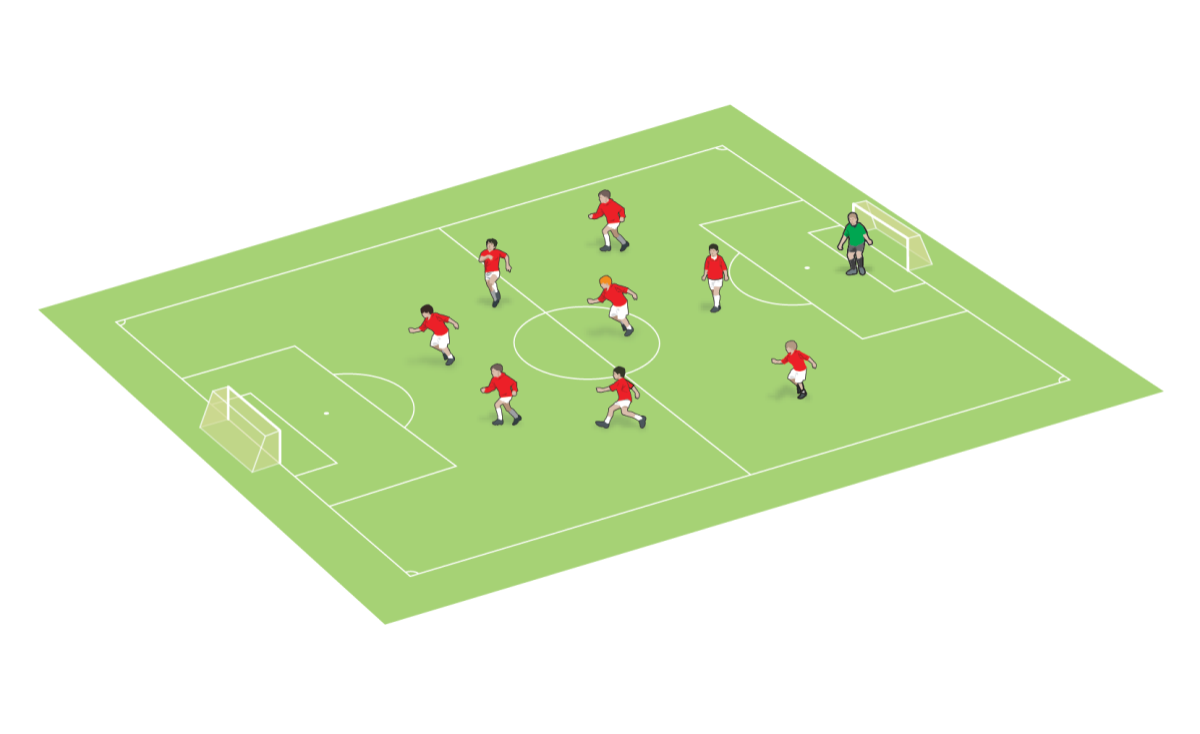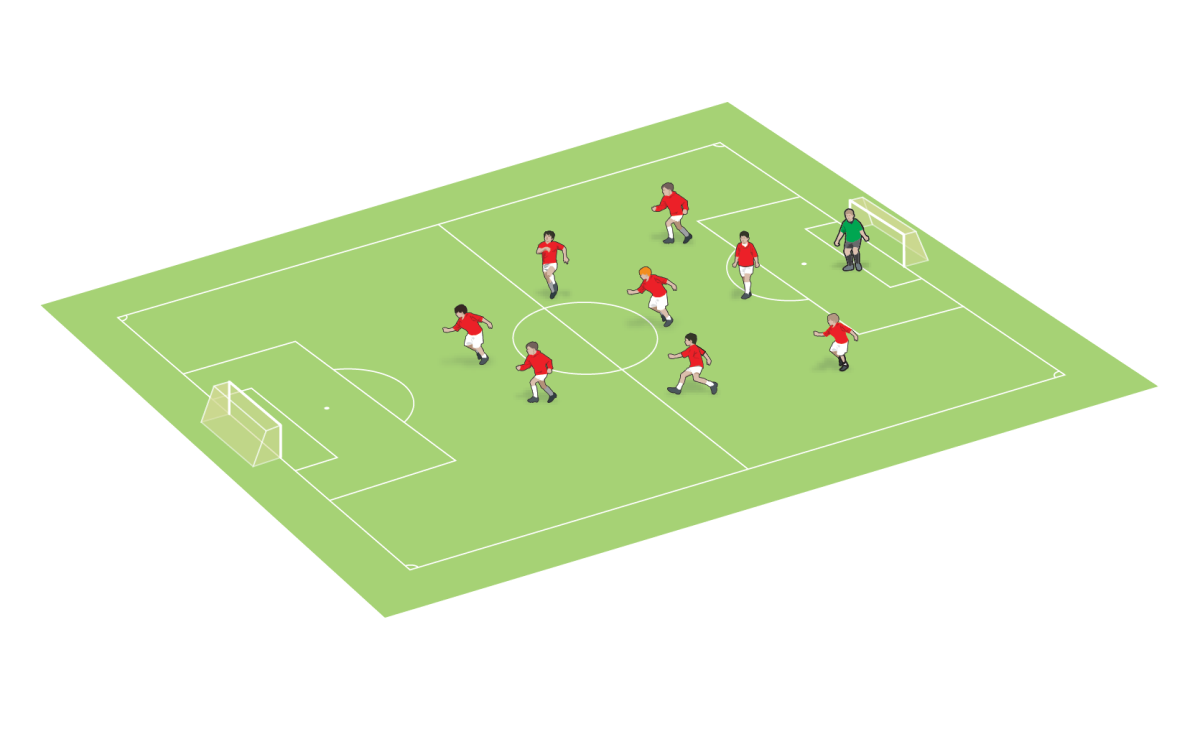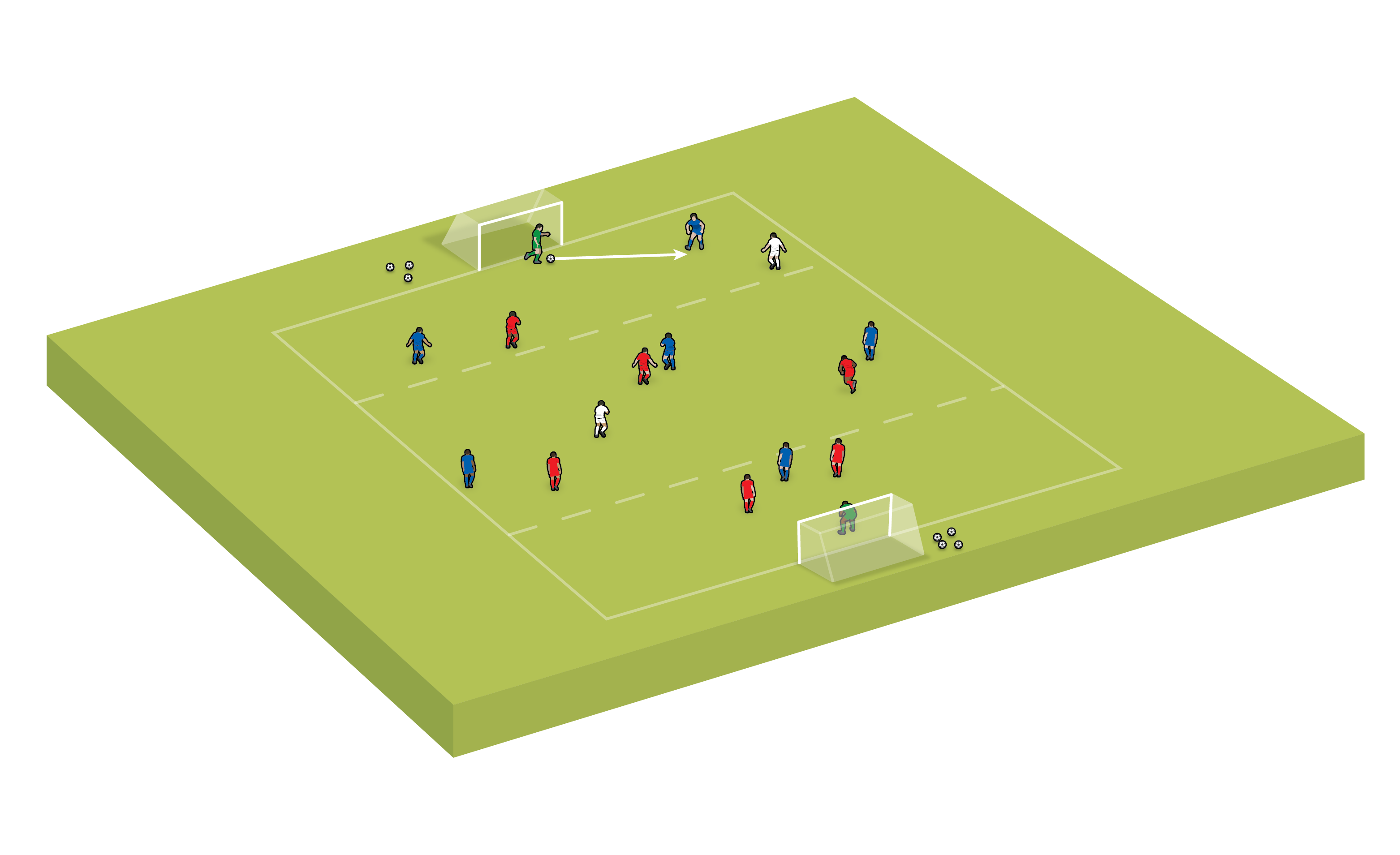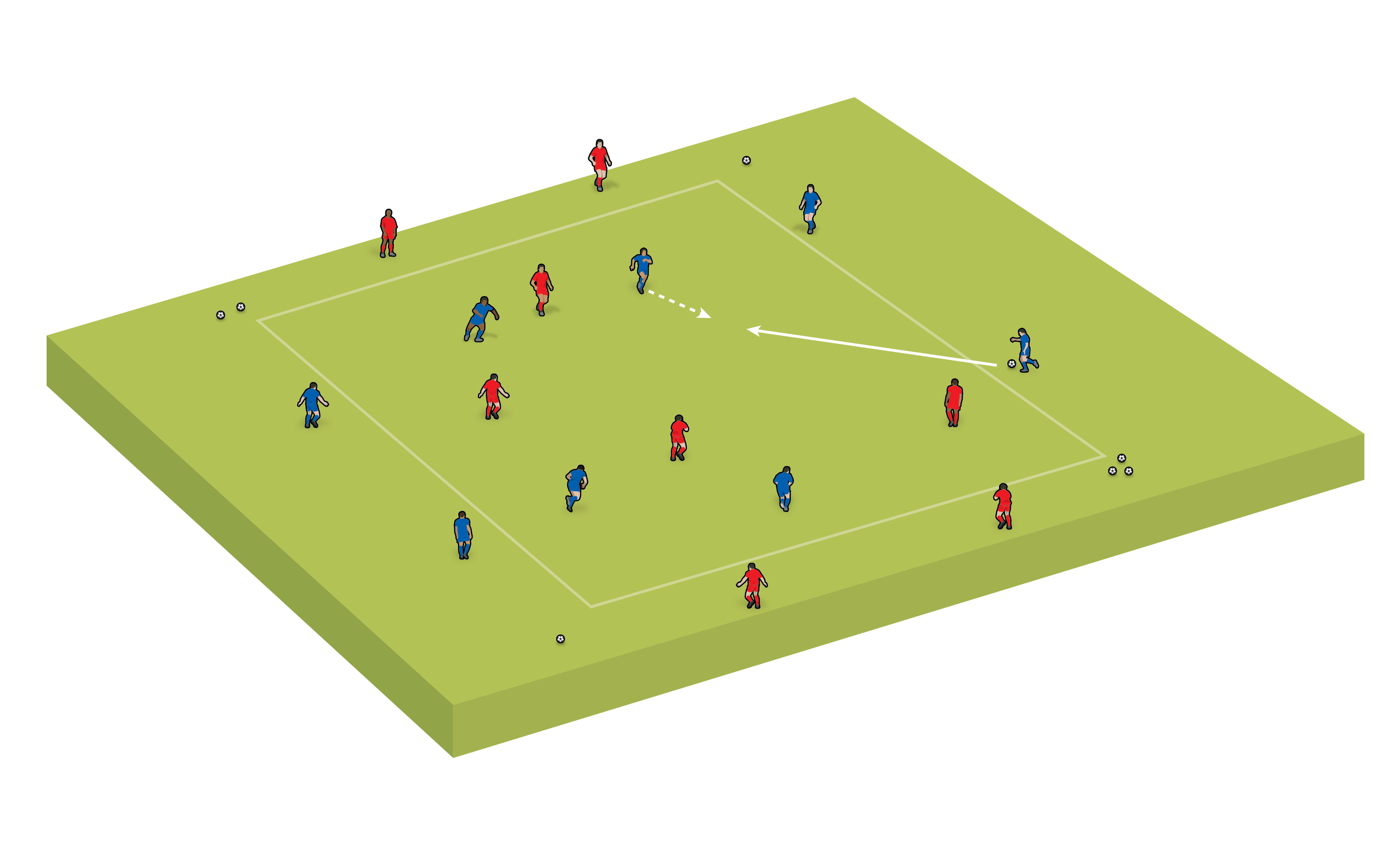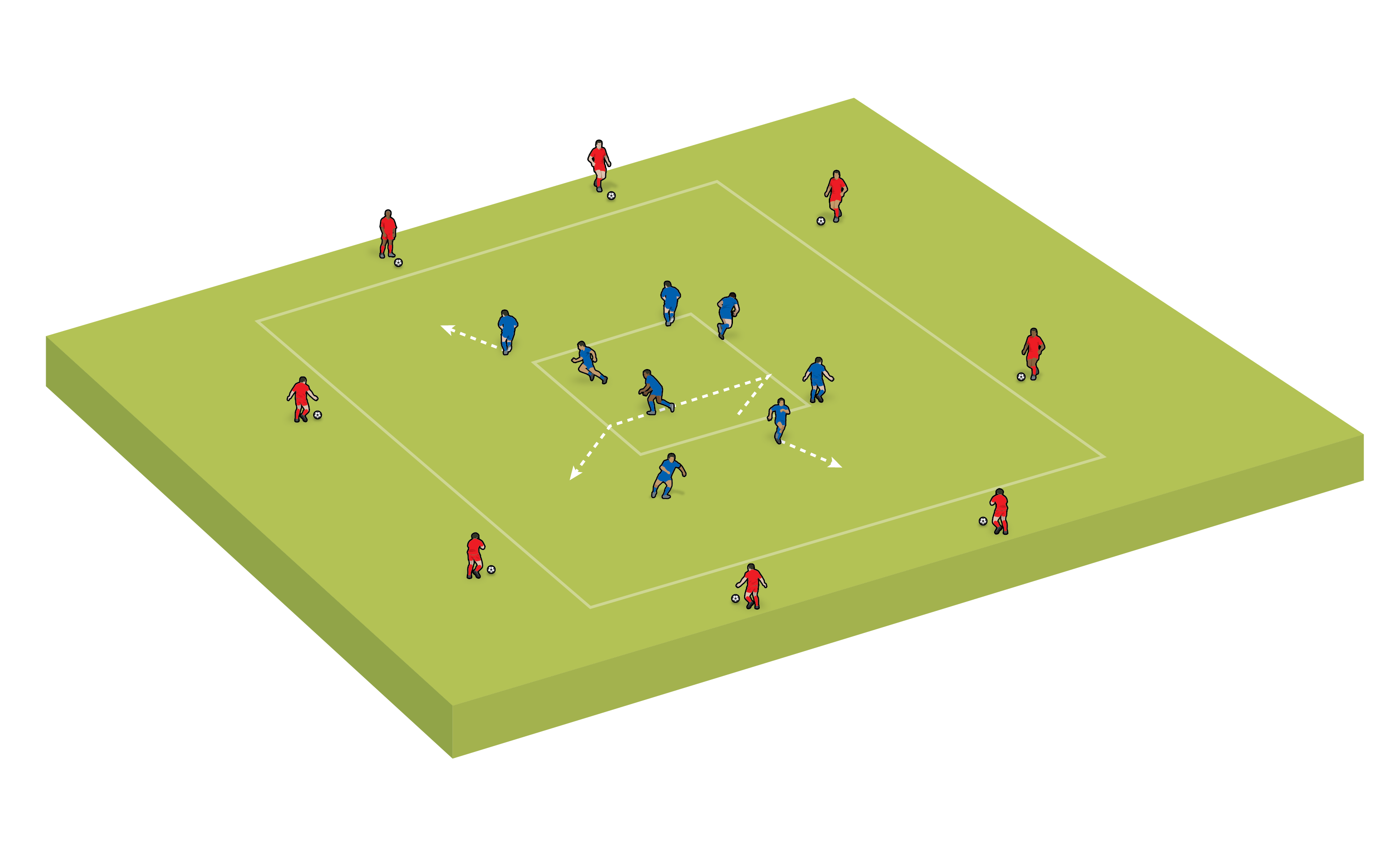9-a-side formation: 3-3-2
Why choose this 9v9 formation? Review the pros and cons, in possession and out of possession principles, and each position
Progresses from: 2-2-2 (7-a-side)
Progresses to: 4-4-2 (11-a-side)
PROS OF THIS FORMATION |
CONS OF THIS FORMATION |
|
|
|
|
|
|
9v9 3-3-2 - IN-POSSESSION SUMMARY
IN-POSSESSION PROS |
IN-POSSESSION CONS |
|
|
|
|
|
3-3-2 IN-POSSESSION - BY POSITION
Goalkeeper
As the majority of support available to the goalkeeper is in the central part of the field, they will have fewer options in wide areas.
Support in those wide areas usually provides the goalkeeper with a ’safe’ option. If the goalkeeper is under pressure and needs to move the ball on quickly, we would usually ask them to try and find a team-mate in a wide position, where losing the ball is less risky than it is directly in front of goal.
But this reduction of support in wide areas will put added pressure on the goalkeeper when they are in possession. They will now need to play a riskier and more challenging central pass more often.
It is also likely that they will look to play longer passes; they may well see it as a safer option, as they will be worried about giving the ball away in a dangerous area of the field.
As coaches, we must support them to find the right balance with their choice of pass.
This will involve allowing them to have the comfort blanket of going long, while also encouraging them to try the shorter, more difficult, pass, that could allow the team to build up effectively from the back.
Central defender
Probably the most important element of the central defender’s role, when the team has the ball, is to get themselves into the right position and avoid getting in the way of team-mates.
If they are not careful, they could find themselves occupying a similar space as that of a team-mate; or, they could move into a position where they are standing within, or blocking, a passing lane that the ball needs to travel along to reach their team-mate.
The most obvious team-mate that they could get in the way of is the defensive midfielder. This is more likely to happen when either of the wide defenders or the goalkeeper are in possession of the ball.
To avoid occupying the wrong space, the central defender will need to constantly scan the pitch – not to ensure they are in position to receive a pass, but to make sure they are not preventing a team-mate from being an option for the player on the ball.
This formation will also allow the central defender to develop their first touch to help them create space and time for themselves.
When the ball is travelling towards them, it is very likely that they will come under pressure from an opponent.
Identifying which foot they should use to receive the pass, where that first touch takes the ball and what it allows them to do with it next will be key to helping them retain possession and prevent the opponent from taking the ball off them in a dangerous area of the pitch.
Related Files
- Central midfielders can combine with each other and the two strikers
- Key requirement for the two forwards is their movement and positioning, both horizontally and vertically
- Wider defenders have two main passing options – into the central midfielders or the strikers
- Defensive midfielder acts as a link between team-mates and different areas of the field
- Central defender must scan to ensure they are not interfering with a passing lane
- Goalkeeper may need to play longer through the middle with fewer wide options available
Wide defenders
When in possession, these two players will probably only have two options if they want to play forward.
They could pass the ball inside to one of the three central midfielders, as with most formations, or take advantage of the space that will be available in the wide areas.
There will be no team-mates positioned in those wide areas and the opposition is unlikely to directly mark the wide defenders, because otherwise they would leave big gaps in the centre.
Therefore, when the wide defender receives a pass, there is an opportunity for them to take a positive first touch into the space ahead of them and then travel with the ball.
As well as developing their first touch and ability to run with the ball, they can also work on how they play a pass while travelling.
Depending where specifically they need to play the pass, there is an opportunity to use the outside of the foot, rather than the inside.
This stops the player from having to break their stride, allowing them to make the pass while on the move and making it a lot easier to disguise.
Slowing down and passing the ball using the inside of the foot takes longer and telegraphs the players intentions, making it easier for the opponent to block or intercept the pass.
"The wide defenders will probably only have two options if they want to play forward..."
The other option for the wide midfielder is to play a forward pass for one of the strikers to run onto.
To do this effectively over a long distance, the weight and area of the pass will be crucial.
Most importantly, though, the player will need to get the timing right.
Playing the pass at the correct time will not only help ensure that their team-mate is able to receive it ahead of their opponent, but also means that they will remain onside to keep the attack progressing.
Defensive midfielder
As with any formation that has three central midfielders, the defensive midfielder plays an important role.
In possession, they act as the link between all of their team-mates and the different areas of the pitch: from one side to the other or from the back to the front.
To do all of this, they will have to be able to perform a number of elements of the game effectively.
They will always need to be available to whichever team-mate has the ball, so their movement and positioning will be particularly important, as will their ability to receive the ball under pressure.
The main action the defensive midfielder will have to perform more often, in this formation specifically, is the forward pass within central areas.
There is a need to get the two strikers involved in the game as quickly as possible. However, with so many players located centrally, this is not an easy task.
So, rather than just looking to pass the ball onto one of the two central midfielders, the defensive midfielder will need to be able to recognise opportunities to bypass them and play it straight into one of the front two.
To do this, they must identify and exploit the spaces within the midfield area of the pitch quickly, before they disappear.
Once a gap has been spotted, it will take an accurate pass, played with a good amount of weight, to ensure the ball is played through a number of players successfully.
Central midfielders
The central midfield players will get lots of opportunities to work on their combination play.
Due to the number of players positioned so far up the pitch, and because they are situated so close together, the two central midfielders and the two strikers will have plenty of opportunities to combine.
Working closely together in tight spaces, an ability to move the ball on with a limited number of touches – while also looking to get on the ball again as soon as possible – will help to move the ball forward and penetrate the opposition’s lines.
There are a lot of components that need to be put together effectively if players are going to combine successfully with a team-mate. These include weight and area of pass, good control of the ball, and awareness.
Another required element is the movement of the player who makes the initial pass, so that they can receive the ball back.
The normal reaction of a player once they make a pass is to stand and watch what happens next. Quite often, this is to see if the pass was successful, analysing their own performance.
However, the thought of moving forward to get the return ball needs to be made before the initial pass is played.
The pass needs to be made as the player is on the move so they can continue with their run. Even if they do not receive the ball back, their movement will help to provide time and space for their team-mate who is now in possession.
Forwards
One key requirement for the two forwards in this formation is their movement and positioning, both horizontally and vertically.
"The central midfield players will get lots of opportunities to work on combination play..."
With a lack of width in this set-up, the strikers will need to identify the moments at which they need to make a run into the wide channels.
For example, when a wide defender is in possession of the ball, they will be looking for a team-mate to play a forward pass to. it is therefore likely that a striker will need to make a run into the channel, to become an available option.
It could be that an attacking midfielder is making a forward run with the ball through the centre. One, or both, of the strikers will then need to vacate this area to help create space for their team-mate on the ball.
In terms of vertical movement, this will also be required within a range of situations and need to be completed in many different ways.
In these moments, it is likely that the two strikers will either move in opposite directions – i.e., one comes short and one goes long – or that one of them holds their position, while their partner drops or stretches the play.
Mostly, these movements will be related to space, either taking advantage of space available – for example, space in behind, if the opposition are playing a high line – or creating space by stretching the opposition players, by increasing the space between their defensive and midfield units.
Quite often, these movements will see the strikers linking up.
This could be the furthest striker receiving the ball and laying it back for their partner, or the striker closest to the midfield unit receiving on the turn and playing it through for the other striker, who is making a run into the space behind the opposition team’s back-line.
9v9 3-3-2 - OUT-OF-POSSESSION SUMMARY
OUT-OF-POSSESSION PROS |
OUT-OF-POSSESSION CONS |
|
|
|
|
|
|
|
|
3-3-2 OUT-OF-POSSESSION - BY POSITION
Goalkeeper
This formation means the central areas of the pitch are likely to be congested, and so the opposition will look to play around the team.
The goalkeeper will therefore need to deal with balls coming in from the wide areas. These crosses will take different forms: high or low, travelling towards the goal or travelling away from goal.
When the ball travels across the box, the goalkeeper will need to adjust their position quickly, allowing them to be in the correct place to give themselves the best chance of dealing with the cross.
They also need to be ready to react to any attempt on goal which follows. Different circumstances will require them to react in different ways.
Where possible, a goalkeeper needs a more controlled movement across goal, so that their feet are in regular contact with the ground to enable them to ‘push off’ and dive to make a save if needed. To achieve this, they will likely need to adopt a side-step technique.
If they need to get across the goal a lot quicker, they will have to sacrifice how often they are in contact with the ground, as well as the quality of that contact, reducing their ability to push off if required to do so.
Central defender
The truly great defenders very rarely put themselves in a position where they have to go to ground.
They have no need for a last-ditch tackle or ’emergency’ defending, as they are able to prevent any dangerous situations from occurring before they have a chance to even develop.
The key to this is their ability to read the game and get themselves in the ideal position where they can either intercept the ball or take charge of the situation.
This ability to be in the right position will be key to this central defensive position.
In most cases, it will initially be the responsibility of one of the wide defenders to leave their position to deal with a problem.
This may involve moving into a wide area to engage an opponent or stepping forward to deal with a player in a central position.
Once this happens, it is important that the central defender recognises this quickly, reads the situation and readjusts their position accordingly.
For example, when the ball is in a wide area, is the player on the ball likely to attempt a cross? If so, what type of cross will it be? Once they have established what they think will happen, they can then place themselves in a position to best deal with the situation.
- Central midfielders try to protect the space while also marking their player
- Forward must show patience and not overcommit in trying to win back the ball
- Wide defenders are likely to find themselves involved in 1v1s and races
- The defensive midfielder provides the defensive line with protection
- The centre-back must be able to read the game and get themselves in the position to intercept the ball
- The goalkeeper needs to deal with crosses from wide areas
Wide defenders
With the central defender offering the cover and support, and providing the intelligent defending, the wide defenders can be more on the front foot in their defending.
They are, therefore, likely to find themselves in a range of different 1v1 situations and will need to defend in a number of different ways, including from behind to try to prevent an opponent from turning, and face to face.
They may also be caught in a race with an opponent and have to make some difficult decisions. If they do not win this, they will find themselves in a 1v1 battle.
If they do get to the ball first, they will have to decide what to do next and then complete a range of techniques while being put under pressure by their opponent.
This could include playing the ball back to their goalkeeper. This is likely to be executed from a wide area, while running towards their own goal and under pressure.
This can be a difficult technique to complete, as the weight and accuracy of the pass are really important.
In other circumstances, they may look to shield the ball and attempt to turn to get away from the opposition player, before travelling forward with the ball.
Whatever it may be, we are now asking them to go beyond just winning the ball; we want them to get to it first and then help the team retain possession, rather than give it straight back to the opposition.
Defensive midfielder
The defensive midfielder helps provide the defensive line with protection.
They try to stop the opposition from playing balls into their attacking players by blocking the pathway between the opposition player on the ball and their intended target.
To be able to do this, they will need to have full awareness of what is around them. They can’t just concentrate on the ball – they also need to be aware of the position of the strikers as well, so that they can put themselves between the opponent and the ball.
Alongside their main defensive role, there is also an opportunity for them to be more proactive and win possession of the ball a lot earlier and quicker. To do this, their defensive duties can begin while their team is in possession.
Being in or around the area of the pitch where the ball is located will help them be in a place to win it back immediately should a team-mate lose it. Or, better still, they can get into a position to support the player on the ball to prevent the team from losing possession in the first place.
Similarly to the central defender, the defensive midfielder needs to learn to read the game and predict what will happen next.
Doing so will allow them to readjust their position on the pitch so they can help to retain or regain possession of the ball.
Central midfielders
Often, when defending, you would look to allow a team to play into the wide areas, stopping them from playing centrally.
But, because this formation is so well-protected and congested down the middle, the opposition can actually be encouraged to play into this central area.
It is likely that the two strikers will try and stop the ball going into the wide areas, with the opposition trying to play around the compactness of the team.
If the strikers do this successfully, the opposition will then either look to switch the play, or play centrally.
If they do the latter, the attacking midfielders will have an important role, as they will be the first unit who can stop their opponents from progressing, while also potentially winning the ball.
Here, the two central midfielders can be introduced to the concept of trying to protect the space while also marking the player.
If they just mark the player, the spaces between them will be too large, making it too easy for the opposition to play through and break lines.
They must position themselves to prevent the opposition from playing through them, while also being able to engage their opponent should they receive the ball.
Forwards
One of the roles of the strikers when defending is to try to prevent the opposition from playing into wide areas.
How they do this will depend on the opposition’s formation – this will impact how they look to play into the wide areas and who specifically they look to get the ball to.
However, there will be common traits the strikers must to follow, no matter who they are trying to prevent from having the ball.
The strikers can’t simply mark opposition players in the wide areas; they must be able to protect a specific area of space as well.
The next step is to put some pressure on the opposition player with the ball. Allowing them to have time and space will make it easier for them to execute whatever they want to do.
The key to this is making sure they prevent the player on the ball passing it to the wide areas as they leave their position.
They therefore need to ensure their movement to close down their opponent is completed on the pathway the ball would need to travel, in order to get to the player in the wide area.
As this is going on, the other striker must start to think about readjusting their position, in case the opponent looks to play across the pitch.
Considering the key principles of defending, it is important that the strikers recognise the need for patience. They must understand that there is absolutely no need for them to overcommit in trying to win the ball.
Their job is to force their opponent to play centrally, where their team-mates have the advantage and, therefore, more chance of winning the ball.
Newsletter Sign Up
Coaches Testimonials

Gerald Kearney, Downtown Las Vegas Soccer Club

Paul Butler, Florida, USA

Rick Shields, Springboro, USA

Tony Green, Pierrefonds Titans, Quebec, Canada
Subscribe Today
Discover the simple way to become a more effective, more successful soccer coach
In a recent survey 89% of subscribers said Soccer Coach Weekly makes them more confident, 91% said Soccer Coach Weekly makes them a more effective coach and 93% said Soccer Coach Weekly makes them more inspired.
*includes 3 coaching manuals
Get Weekly Inspiration
All the latest techniques and approaches
Soccer Coach Weekly offers proven and easy to use soccer drills, coaching sessions, practice plans, small-sided games, warm-ups, training tips and advice.
We've been at the cutting edge of soccer coaching since we launched in 2007, creating resources for the grassroots youth coach, following best practice from around the world and insights from the professional game.
